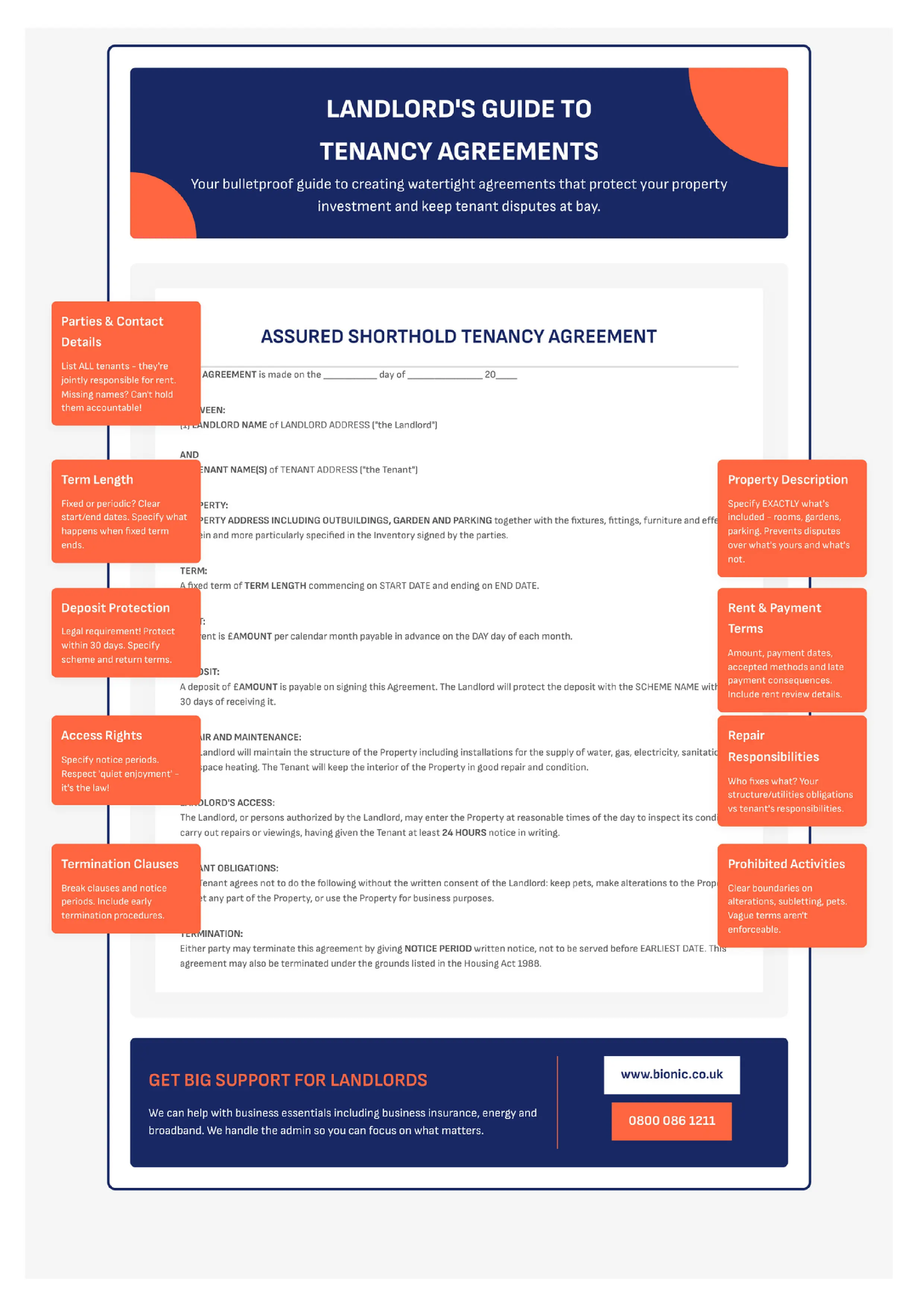How to write a legally binding tenancy agreement: A guide for UK landlords
Bringing on a new tenant is an exciting prospect for any landlord. Good tenants bring in income and speak up about their needs so you can address issues quickly and keep the relationship nice and healthy.
But not all tenants play by the same rules. While most are a pleasure to have around, there’s always the small risk of those who can cause trouble, damage and put you in debt. If it all ends with a sticky eviction process, you could even be hit by a lot of legal expenses.
However, you can limit the likelihood of any issues with a well-thought-out tenancy agreement that both parties can sign ahead of time.
In this guide, we’ll explain what a tenancy agreement is, what your and your tenant’s rights are, and how to put together a tenancy agreement that works for both of you.
What is a tenancy agreement?
A tenancy agreement is usually a written document that outlines the conditions of a tenancy in rented accommodation. It outlines the landlord’s expectations of the tenant, what the landlord promises to do in return and the rights that both parties have. Once signed, the agreement is legally binding.
Tenants can read through the agreement before signing on to a tenancy. This gives them a chance to ask their new landlord or letting agent about any clauses of which they’re unsure.
Written vs oral tenancy agreements
There are two forms of tenancy agreements:
A written tenancy agreement
This is the most common form of contract. It must be signed by all tenants who will be living at the address as well as the landlord. Putting the agreement in writing has advantages for both the tenant and the landlord: it clearly lays out the rules that both parties have agreed to, meaning an intermediary can use it to determine who is at fault if there’s a legal dispute — for example, if a tenant damages your property.
An oral tenancy agreement
This is simply a verbal agreement between the landlord and the tenant. They’re most common when a tenant is renting directly from a landlord rather than through a letting agent, especially if the tenant knows the landlord personally. Oral tenancy agreements are still legally binding, but they’re very difficult to enforce since there are no clearly agreed-upon terms.
For landlords, getting a written agreement is especially important. Without one, regaining possession of your property is far more difficult: courts will normally require a signed document as evidence before issuing a court order that lets you evict an unruly tenant.
What are the types of written tenancy agreements?
Fixed-term
Fixed-term tenancy agreements normally last for 6 or 12 months at a time. On a fixed-term contract, tenants can leave on the last day of the contract without providing their landlord with any notice. Staying past the date agreed on a fixed-term contract means the tenant is rolled onto a period term contract unless the landlord agrees to them leaving.
Landlords can ask a tenant to leave the property at the end of a fixed-term as long as they give the tenant at least two months’ notice in writing. To do this, you’ll need to submit a section 21 eviction notice.
Fixed-term contracts often contain a break clause. Break clauses let a tenant end the agreement early if they meet some outlined conditions first. For example, a 12-month fixed-term contract might have a break clause that states tenants can leave after the first six months of the agreement as long as they provide the landlord with at least one month’s written notice.
Period-term
Unlike a fixed-term tenancy, periodic agreements don’t have a defined end date. Instead, the tenant simply agrees to give the landlord notice that they’re leaving the property when they’re ready.
Normally, period-term notice periods are about four weeks but they can be longer. This notice must be provided in writing to the landlord for it to be valid.
What are the tenant’s rights?
A tenancy agreement should always lay out a list of the tenant’s rights.
As a landlord, you should be aware that there are universal rights given to all tenants regardless of whether or not they’re detailed in your contract. Your tenant has a right to:
- Live in a safe property that’s in good condition
- Know who their landlord is
- Be protected from unfair evictions
- Challenge excessively high rent and charges
- Have their deposit returned when the tenancy ends (as long as there are no breaches in the tenancy agreement such as damage to the property)
- See a valid Energy Performance Certificate before moving into the property
For more information on tenant rights, visit the government website.
What are your rights as a landlord?
Likewise, the tenancy agreement should also outline what you can reasonably expect in return from your tenant. Typically, you have the right to:
- Expect your tenants to take proper care of the property
- Ask your tenants to take reasonable measures to maintain the property (e.g. turning off the water at the mains if they’re away from the property during winter)
- Be paid the agreed rent on time (even if there are repairs you still need to carry out or your tenant is disputing a charge)
- Ask your tenant to pay for any damage they or one of their guests caused
- Dictate that your tenant does not sublet your property (unless you agree to it)
- Pay any bills that aren’t included in the rent on time e.g. council tax or water
If your tenant violates these rights, you may be able to take legal action to evict them.
What are your responsibilities as a landlord?
There are several legal responsibilities you have as a landlord regardless of whether you outline them in the tenancy agreement. Failure to meet these obligations may result in fines or even prison time in exceptional circumstances.
As a landlord, you must:
- Provide a tenancy agreement that complies with the law
- Provide tenants with a copy of the ‘How to rent’ guide if your property is in England (or a tenant information pack if you live in Scotland)
- Give tenants at least 24 hours' notice before carrying out any inspections of the property (unless it’s an emergency)
- Make sure gas equipment is safely installed and maintained by an engineer on the Gas Safe register
- Arrange for a qualified engineer to do an annual gas safety inspection
- Provide your tenant with a copy of the gas safety check record when they move in
- Ensure all electrical appliances, sockets and light fittings are safe
- Follow all current health and safety regulations for private housing
- Provide smoke alarms on each floor
- Provide carbon monoxide alarms in any room with a coal fire or wood-burning stove
- Ensure your tenants have easy access to a fire escape route on each floor
- Provide fire extinguishers in large properties like houses in multiple occupation (HMOs)
- Resolve any repairs as quickly as possible
- Consider residential landlord insurance, or if you're renting to a business, commercial landlord insurance.
Visit the government website for more information about your responsibilities to tenants.
How to write a tenancy agreement
Tenancy agreements can vary depending on the type of property you’re letting, for how long, and to whom you’re letting it – whether it’s residential or commercial. But there is some guidance.
Here is an example of how you should fill in your tenancy agreement.

There are a few things you should always include in your tenancy agreement though. These are:
- Property address — Make it clear which property the agreement refers to by writing out the full address at the beginning of the agreement.
- Contact details — Make sure your tenancy agreement has the contact details of both parties. If you don’t provide at least your name and address, you could be fined.
- The time frame — Outline how long the tenancy will last if you’ve chosen a fixed-term contract. If you’re instead opting for a period-term tenancy, clearly state this in the agreement, and detail the date of each month that the next period starts.
- The agreed rent and payment date — The agreed rental amount should be clearly displayed in the tenancy agreement in pounds and pence. You should be clear about the period the payment covers: if you expect quarterly payments, clearly state this on the agreement. You should also make clear when you expect to receive payment (e.g. “The 1st of each calendar month”).
- The deposit amount — Most tenancy agreements require a deposit, often equivalent to about one month’s rent. Clearly state the deposit amount in the agreement and the measures you’ll take to protect the deposit; for example, via the Deposit Protection Service (DPS).
- The rights of each party — It’s always helpful to detail the rights of both the tenant and the landlord to minimise the risk of an accidental breach.
- Utilities and bills clarity - It’s important to be clear about who pays for what. Your tenancy agreement should state who is responsible for council tax, gas, electricity, water, and broadband. How meter readings will be taken and bills split (if relevant) and what happens if a bill is unpaid.
- If you allow pets or animals – Some tenants may want to move in with furry friends, it’s a good idea to make your decision clear in the contract, in case of any damages caused by pets
- Custom clauses – Do you allow subletting? How often will there be a rent review? What is the break clause? Outline these in your terms to avoid disputes down the line
- What happens if the agreement is terminated — This includes things like how much notice you require if a tenant wants to end the agreement early, and how much notice you’ll provide them before an eviction. It’ll also detail what will happen with the tenant’s deposit.
Looking for a tenancy agreement example? LawDepot provides this free template you can use to get started.
This guidance is for informational purposes only and is not legal advice. Always consult your own solicitor for legal advice with contracts.
Can I write my own tenancy agreement?
You don’t necessarily need a solicitor to produce a legal document like a tenancy agreement. You can do it yourself, just make sure to include all the relevant information. Ensure it is up to date with the law and in particular does not contain any illegal clauses. For example, requiring the tenant to pay unreasonable costs is illegal so you cannot request anything like this.
If you’re not sure what needs to be in the agreement, then you should seek professional legal help.
What documents are required for a private rental agreement?
To set up a rental agreement, both landlords and tenants need to provide several important documents. As a landlord it’s important you do your part as well as your prospective tenant. You should gather:
- Proof of right to rent - Tenants must they have the right to rent in the UK. They must show a valid passport, or if not a British Citizen, a biometric residence permit, or a share code from the Home Office.
- Proof of identity and address - Tenant's must show proof of where they’ve lived previously so you can carry out necessary checks. This can include a passport, driving licence, or recent utility bill.
- References - You are within your right to ask for employment references, previous landlord references, and credit checks to confirm against what the tenant says.
- Safety Certificates - As a landlord you must provide up-to-date gas and electrical safety certificates, an Energy Performance Certificate (EPC), and a copy of the government’s ‘How to Rent’ guide.
- Deposit Protection Information - If you take a deposit, it’s a good idea to put in a protection scheme and information on this should be provided to the tenant(s).
Do all tenants need to be on the tenancy agreement?
If there are multiple adults living in the property, it’s a good practice for all tenants to be named on the tenancy agreement and to sign it. This is especially important for joint tenancies, where all tenants share equal rights and responsibilities and are jointly liable for rent and any breaches of the agreement.
Alex McCloy, Legal Counsel at Bionic, states, “If only one tenant is named on the agreement, this can limit the legal protection for other occupants and may not be suitable for shared households. Having all tenants on the agreement ensures clear accountability and makes it easier to resolve any disputes. Once signed, each tenant should receive a copy of the signed agreement for their records.”
How legally binding is a tenancy agreement?
A tenancy contract becomes legally binding when it includes all the essentials outlined and it’s signed by all parties. A tenancy agreement is a legally binding contract and must be respected by both parties as soon as you have both signed it.
As a landlord, your signature acts as your agreement to carry out all the duties outlined in the contract. Similarly, as a tenant, you must abide by any rules in the agreement once you have signed.
What happens if there is no rental agreement?
If there is no tenancy agreement that means there is no legal agreement in place.
For example, if you are a landlord and your tenant leaves your property in a bad condition, you have no legal authority to deduct money from their deposit if you don’t have a rental agreement.
If there was an agreement in place that stated they should not leave the premises in an unacceptable state, then you’d be able to keep their deposit. Make sure you always chalk up a legal contract as a landlord, this will protect you from issues with tenants in the future.
Are there regional differences for tenancy contracts?
Landlord laws aren’t the same across the UK. Here’s a quick comparison for England, Wales, Scotland and Northern Ireland.
| Region | Key Differences |
| England | Most use Assured Shorthold Tenancies (ASTs). Deposit protection required by law. |
| Wales | Uses “Occupation Contracts” since December 2022. Different notice periods. |
| Scotland | Private Residential Tenancies are standard. No fixed end date. |
| Northern Ireland | Tenancy agreements must be in writing. Different notice and deposit rules. |
Always check the latest local government guidance before finalising your agreement.
How to stay up to date with government changes?
In the UK, the Renter’s Rights Reform bill is currently being pushed through parliament and likely to become law in the latter end of 2025.
The Bill is set to bring some big changes to landlords in the private renting sector, including:
- Fixed-term tenancies will disappear, and tenants will be able to stay until they serve notice
- Section 21 and ‘no fault’ evictions will be abolished
- Landlord registration will become mandatory
This bill aims to give more rights to tenants and to crack down on the minority of landlords who exploit their tenants by demanding multiple months of rent upfront and evicting tenants to hike rent up – to name a few of the issues.
So, as a landlord, it’s a good idea to stay clued up on what’s changed when the bill is passed.
You can read it in full here.
How to protect your property
Having a written tenancy agreement in place is vital if you want to ensure a long and successful tenancy. It protects both you and the tenant, helping to keep your income protected and your reputation intact.
At Bionic, we can help sort property maintenance insurance and commercial property insurance for landlords like you to help keep you protected. Start a business insurance quote online today or learn more by reading up on more insurance guides.








